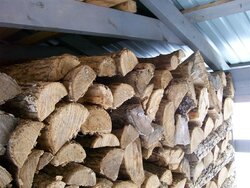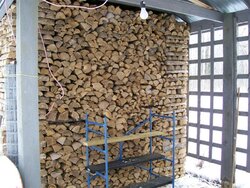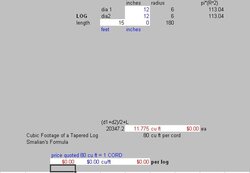was wondering,how may logs at 15 ft. long and 12 inches in dia.would it take to have a cord of wood4X4X8.
how much wood per tree length
- Thread starter henfruit
- Start date
-
Active since 1995, Hearth.com is THE place on the internet for free information and advice about wood stoves, pellet stoves and other energy saving equipment.
We strive to provide opinions, articles, discussions and history related to Hearth Products and in a more general sense, energy issues.
We promote the EFFICIENT, RESPONSIBLE, CLEAN and SAFE use of all fuels, whether renewable or fossil.
You are using an out of date browser. It may not display this or other websites correctly.
You should upgrade or use an alternative browser.
You should upgrade or use an alternative browser.
- Status
- Not open for further replies.
Got Wood
Minister of Fire
Eric Johnson
Mod Emeritus
I guess I'm coming up with a little different answer:
pi x radius^2 x length = cubic feet of wood per log
for a 15 foot x 1 foot log:
3.14 x .5 ft ^2 x 15 = 11.77 cubic foot of solid wood per log
http://firewoodresource.com/articles/cord.html
So:
Max = 90 cu ft / 11.77 = 7.6 logs
Avg = 80 cu ft / 11.77 = 6.8 logs
Min = 70 cu ft / 11.77 = 5.9 logs
pi x radius^2 x length = cubic feet of wood per log
for a 15 foot x 1 foot log:
3.14 x .5 ft ^2 x 15 = 11.77 cubic foot of solid wood per log
In any stack of wood there will be air space between the pieces. As a result a cord of wood may only have 70-90 cubic feet of actual solid wood. This varies with the size and shape of the wood and how tightly it is stacked.
http://firewoodresource.com/articles/cord.html
So:
Max = 90 cu ft / 11.77 = 7.6 logs
Avg = 80 cu ft / 11.77 = 6.8 logs
Min = 70 cu ft / 11.77 = 5.9 logs
Eric Johnson
Mod Emeritus
I calculated how many of those logs it would take to make 1,000 board feet and cut the number in half, since there are generally thought to be about two cords per MBF. That's a very rough measurement (different log scales yield different BF totals for the same logs), but I came up with 8.5. So it's somewhere between 8 and 9 logs, by that measure.
vwboomer said:There is no airspace in the log.
Actually, there's more than you might think, especially as it seasons. But that's not the airspace we're talking about. Even if you stack those logs just as they are, the stack you come up with is not going to contain solid wood within it's exterior dimensions. A cord of wood is typically defined, as you stated, as 128 cubic feet of neatly stacked split wood. A 4'x4'x8' stack fits the definition. That neatly stacked cord of wood is going to have anywhere from 15% to 30+% airspace in it. So your 128 cubic foot cord will actually contain maybe ~80 or 90 cubic feet of wood, as cozy said. In any case, the answer to the OP's question seems to be ~ 8 or 9 of those logs should yield about a cord of split & stacked firewood. Rick
Eric Johnson
Mod Emeritus
And it's going to shrink as it dries. Some people thing that's a negligible factor, but if you have a good pile of wood--say 10 or 20 cords, you could easily lose the better part of a cord as it dries. That's one thing people don't realize about the firewood business--dry wood costs more not only because somebody sat on it long enough for it to dry, but they wind up with less wood than they started with, and have to add more to make it come out to a full cord for the customer.
Eric Johnson
Mod Emeritus
I figured out how much at one point, but the thread was lost on the old forum (before we got this fancy software) and it's gone. I stack my wood 6.5 feet high, and I think a green stack shrunk down to something like 6' over the course of the summer and fall. So that would be 7.6%. Nothing to sneeze at. That's 3/4 of a cord lost for every 10.
Nothing to sneeze at, fer sure, but it's a good thing, and what seasoning's all about...getting that nasty moisture out of the firewood. Yes, a cord of wood stacked green turns into less than a cord of seasoned wood, but I'll live with that. Rick
Eric Johnson
Mod Emeritus
I work with a lady who had a dog once that would steal wood from the neighbor's pile and bring it home. I think they trained him to do that, though they deny it. So losses are not always limited to drying.
Another friend had a dog that would run in front of you and break trail on backcountry skiing trips. It was great for the most part, except that sking around in those tight little circles periodically would get a little old. That and chasing rabbits.
Another friend had a dog that would run in front of you and break trail on backcountry skiing trips. It was great for the most part, except that sking around in those tight little circles periodically would get a little old. That and chasing rabbits.
LLigetfa
Minister of Fire
Ja, I stack my wood 9 feet tall in my woodshed and I've seen that phenomenon when I stacked very green wood rows right tight together. As the face row shrank, the edges would catch on the previous row and also the exposed face dried and shrank at a faster rate than the backside causing the face of the last row to curl away and topple.fossil said:^ Yup. Not so much in length so's you'll notice, but most certainly in breadth. I've had perfectly stable stacks teeter as they seasoned, because of the shrinkage of the wood. Rick
I stack right tight to the rafters and have seen as much as a 9 inch gap form as it shrank. Given the height of 9 feet, that is about one inch per foot so 1/12th or 1 cord lost in 12 cord to shrinkage. I don't usually stack green wood in the shed, preferring to leave it loose piled out in the sun and wind for a few months first. Here are a couple of pics of wood that sat out first. There is less than 4 inches of gap.
Attachments
henfruit said:was wondering,how may logs at 15 ft. long and 12 inches in dia.would it take to have a cord of wood4X4X8.
A good source of info for log scaling :http://www.for.gov.bc.ca/hva/manuals/scaling/pdf/Ch4.pdf
cozy heat has the right answer at 11.77 cu./ft. per log
I put a spreadsheet together for buying logs using Smalian's log scaling formula
Attachments
kenny chaos
Minister of Fire
Using a different method: My woodlot tables shows one log would be .145 cord or 6.9 trees for a cord.
It's not difficult to calculate the volume of a cylinder. It is very difficult to find a log that's a cylinder. After the log is bucked, split, and stacked, there will be a neat stack of wood that came from the log. The stack will have a significant percentage of empty space in it...depending on the size, straightness, and shape of the splits, and how tightly the wood is stacked. There's nothing whatever precise about this, it's all just estimation. Rick
kenny chaos
Minister of Fire
- Status
- Not open for further replies.
Similar threads
- Replies
- 34
- Views
- 4K
- Replies
- 7
- Views
- 676
- Replies
- 30
- Views
- 3K




